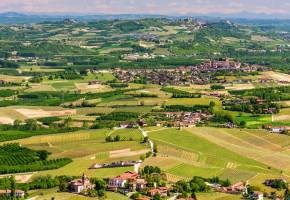Following Leonardo da Vinci's footsteps in Italy
While it is true that many of Leonardo da Vinci's most famous works are abroad (think the Louvre), Italy retains an astonishing "collection" of his genius. Unrivalled works of art, but also technological inventions that would make today's tech geniuses pale. But also architecture and sculptures, treaties of anatomy and on the most disparate fields of general knowledge.
In Tuscany where he was born
His first certain work dated and signed in 1473 is the drawing ''Paesaggio con Fiume'' (Landscape with river) now exposed in the Cabinet of drawings and prints of the Uffizi. Still, at the Uffizi you can see many of his works including the famous Annunciazione, of which there is a second smaller version preserved in the Louvre and the unfinished Adoration of the Magi. But Tuscany celebrates its great genius also, or above all, in Vinci. Start with a visit to the Leonardo Museum, which focuses attention on its inventions, including war machines, instruments, and revolving cranes. Continue your tour to discover the works of contemporary art that the village has dedicated to him. Like the Piazza Dei Guidi designed by Mimmo Paladino.
Keep going and, after three kilometres, you'll find Anchiano, Leonardo's birthplace. Here a life-size Leonardo hologram meets visitors, telling images, memories and landscapes of his life between Vinci and Florence.

Florence, panoramic view
In Milan, where he spent most of his life
It is not for nothing that the Museum of Science and Technology is named after him. And any tour of Leonardo should start here.
The museum houses dozens of Leonardo's machines whose sketch versions are contained in many of the treaties preserved at the Pinacoteca Ambrosiana, another cult place for fans of the Tuscan genius.
Another Milanese stop is the Cenacolo Vinciano. A visit to the Last Supper is a must for anyone walking in the city but needs to be booked well in advance.
But the Leonardo genius is also made of architecture and great works. So much so that many often attribute to Leonardo the design of Milan's water canals.

Milan Cathedral from the Square
His project was beautiful: connecting the river Adda with the Ticino in an extraordinary system of canals.
But this was not the only one unfinished project. Famous is the story of the bronze statue of Leonardo's horse that Ludovico il Moro commissioned him, but which was never completed except in a partial version today exposed at the entrance of the Hippodrome.
Vigevano
The permanence of Leonardo in these areas is well documented and the evidence of his cultural heritage are many. Starting from the stable of the Castello Sforzesco, the covered and the elevated roads. And then there is the Piazza Ducale that, undeniably, recalls Leonardo's drawings of the ideal city.
The water mill of Mora Bassa dell'Est Sesia, a fifteenth-century residence and meeting place between Ludovico il Moro and Cecilia Gallerani (the Lady with the Ermine), today hosts a permanent exhibition on Leonardo's machines.
And at the castle of Vigevano is another Leonardo museum. An interactive institution that proposes a journey through life and the works of the Tuscan genius.
In the Vatican City

The Papal Basilica of St. Peter in the Vatican





